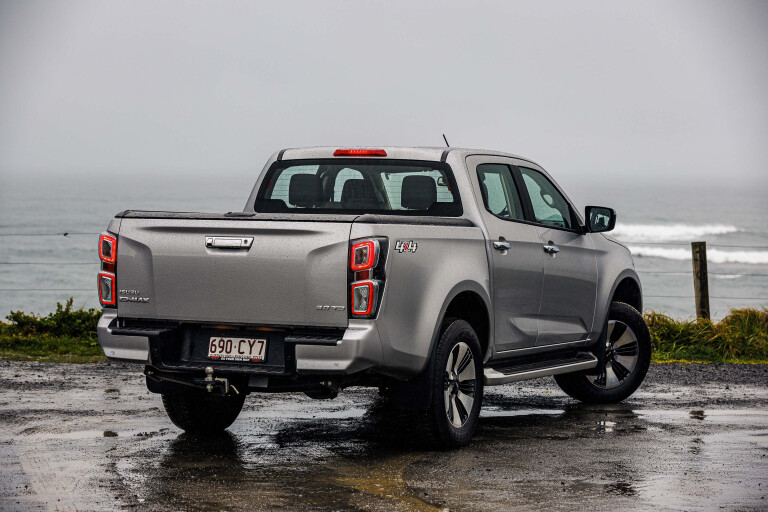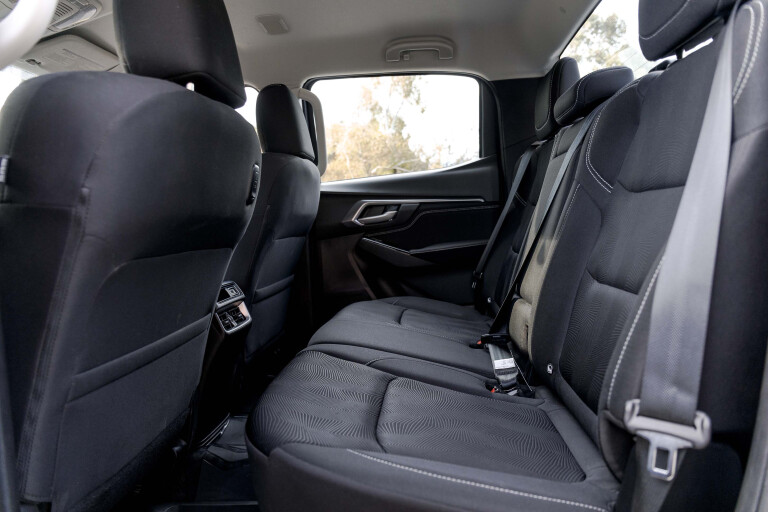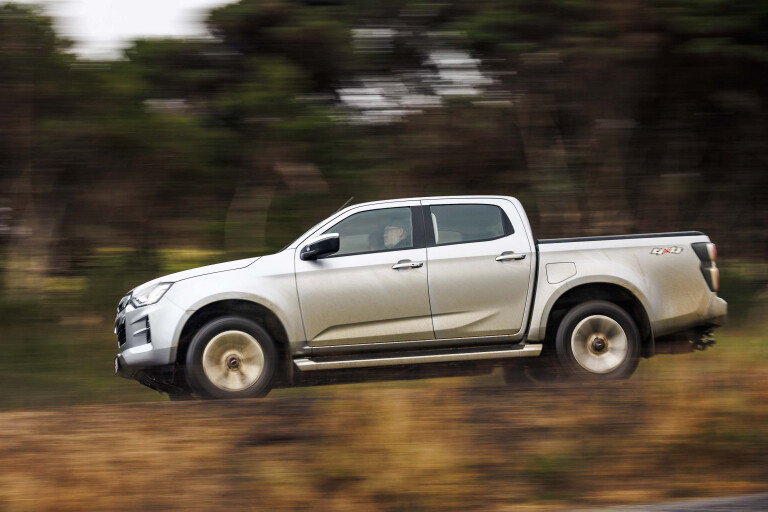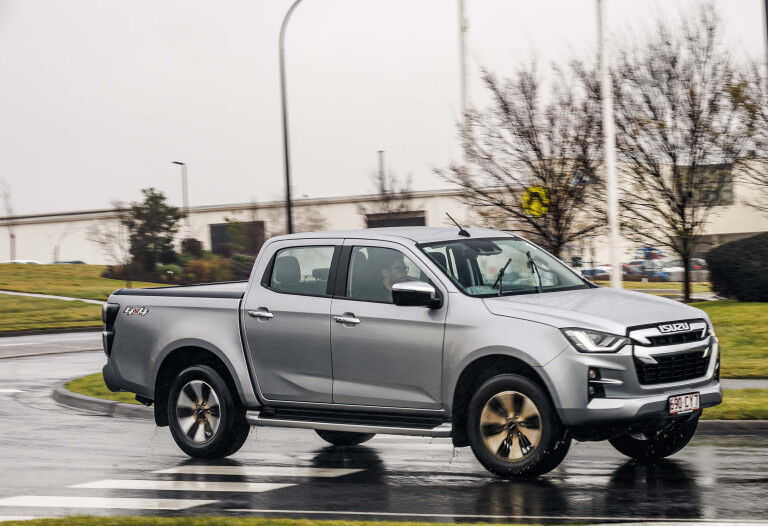
Score breakdown
Things we like
- Strong engine performance
- Impressive steering calibration
- Practical materials and design
Not so much
- Engine refinement needs improving
- Lack of tray practicality compared to rivals
- Six-speed transmission outmatched in current market
The remarkable thing about the 2022 Isuzu D-Max LS-U is that it feels purposeful, utilitarian, and practical, but without simultaneously sacrificing much in the way of day-to-day useability. It is a dual-cab ute that is designed to be used as dual-cabs are – by loading up the tray, hitching on a trailer, and going where other SUVs and soft-roaders do not dare.

JUMP AHEAD
- How much is it, and what do you get?
- How do rivals compare on value?
- Interior comfort, space and storage
- What’s the payload and is the tray practical?
- What is it like for towing?
- What is it like to drive?
- How is it on fuel?
- What about the new 2023 update?
- VERDICT
- Specifications
How much is it, and what do you get?
The D-Max is one of the freshest utes available thanks to recent updates following its 2020 launch in second-generation form. It has a list price of $59,000 before on-road costs, or $66,119 drive-away.
In LS-U trim it’s powered by Isuzu’s venerable 3.0-litre turbo diesel and is strong on safety and drive-assistance technology. A recent update has added a 1.9-litre engine to the D-Max range, but the 3.0-litre is still the best option. You can read more about the most recent model year update for the D-Max later in the review, with new additions including keyless start for extra convenience.
Eight airbags are standard, along with several other active safety tech features, which combine to give the Isuzu D-Max a five-star ANCAP rating from testing in 2020.

How do rivals compare on value?
The Isuzu D-Max offers good value when compared to key rivals like the 2.0-litre Ford Ranger XLT ($61,190 sticker, $67,543 drive-away).
However, its Mazda BT-50 twin under the skin costs $57,290 in comparable GT trim ($66,939 drive-away if you hold an ABN), and the similarly utilitarian-focused Mitsubishi Triton GSR wears a $55,690 sticker (currently $65,190 drive-away for ABN holders including a roll-top tonneau).
The Toyota Hilux SR5 ($58,680/$66,201 drive-away) and Nissan Navara ($58,730/$65,680 drive-away) are close to the Isuzu in price.
Service intervals for the D-Max are 15,000km or 12 months, with seven capped-price services available until seven years or 105,000km have elapsed. The first service costs $409, with subsequent trips to the dealer hovering between $319 and $769.
Interior comfort, space and storage
Whereas the Mazda BT-50 has easily the most car-like of ute cabins with its tasteful two-tone upholstery and a logical dashboard layout, the related Isuzu D-Max lacks its platform partner's more luxurious cabin finish, electric driver’s seat adjustment, classier black roof lining and heated front seats.
At least the Isuzu's front seats are as comfortable as they look and offer a generous 90mm of headroom for the driver. The impressive 9.0-inch central touchscreen matches that of the BT-50 and while it has sharp graphics and decent features, the system takes more than 20 seconds to boot up after the engine is started – the longest of any ute in our recent giant dual-cab comparison.
Unlike some others, the touchscreen does not incorporate the climate control functions, which are instead housed in a specific panel below with a clear digital display and hard switches.


Also common to both Isuzu and Mazda are a small, sporty and ergonomic steering wheel covered in top-quality leather with two-way adjustment, an upholstered dashboard with real stitching, a big phone storage tray and a USB-A port plus 12-volt power outlet for the front row.
There’s also a neat double glove box, which the Isuzu adds to with a further lidded cubby on top of the dash.
Second-row passengers are also well looked after with a whopping 100mm of knee room, another USB socket, ample toe room, ceiling-mounted speakers and great visibility even for smaller occupants.
Headroom is limited in the second row compared to the front, with just 40mm of space and the rear doors don’t open as wide as some other utes which could make loading people and things a little trickier.
The D-Max gets pleasant cloth upholstery and manual driver’s seat adjustment, although electric lumbar support adjustment is curiously shared with the Mazda.

What’s the payload and is the tray practical?
The LS-U grade D-Max comes equipped with a hard roller tonneau cover, which is simple to operate and an effective way to keep gear locked away from prying eyes.
However, it does take up valuable real estate and will be the first thing tossed if you use the tray for adventure or work – which is why you'll find a bunch on online marketplaces.
Unfortunately, the tray only features two tie-down points towards the rear, which is near the lower end for the current market. The D-Max in LS-U trim as tested here has a 995kg payload.

What is it like for towing?
If you, like many Australians, are looking to haul a trailer, caravan, boat, or similarly hitched wagon with your dual-cab, the D-Max LS-U makes a compelling choice. It boasts an official braked towing rating of 3500kg, with a 6000kg gross combination mass.
During our testing, we found the six-speed automatic a touch too keen to shift into higher gears, though it has a simple-to-operate gear selector that allows the driver to choose the appropriate ratio as needed.
While its slightly firm suspension tune can be a small negative while driving unladen, it proved to be a considerable boon during our tow test.
Overall the D-Max proved to have impressive control and composure when towing. It also boasted the best fuel consumption when towing that we have encountered, using just 15.3L/100km.

What is it like to drive?
The Isuzu D-Max isn’t the final word in dual-cab driving refinement but given its real-world capability off the beaten track, this is very easily forgiven.
It should also be noted that even with a more utilitarian bent, the D-Max still outclasses key rivals in the segment when it comes to on-road driving.
We were impressed by the relatively responsive engine, which provides a surge of torque from 2000rpm through a sweet spot at 3500rpm.
Although it has fewer ratios than rivals, the six-speed automatic transmission has an intuitive calibration. Its only major downfall is a tendency to hold onto revs more than we’d like on prolonged downhill sections.

A stiffer suspension calibration means the D-Max has the characteristic dual-cab ‘patter’ in most urban environments, but this is offset by excellent (for the class) cabin refinement. With Bridgestone Dueler H/T tyres, the D-Max impressed us with its ability to keep road and tyre noise in check.
Our biggest highlight though was the steering. This is a massive step up from the old model and will have few drivers complaining – particularly if they have much exposure to other key dual-cab models. The steering wheel itself is nicely proportioned and is weighted in a sweet spot that balanced around-town commuting needs and highway stability with agility at slow speeds.
While there is some stiff-legged compromise, we found the D-Max to be a true ‘Jack of all trades’ when it came to driving needs.

How is it on fuel?
During testing we found the D-Max consumed fuel at a rate of 9.65L/100km, making it the third most efficient from our recent dual-cab group test.
The only models that used less fuel during testing were the Mazda BT-50 (9.3L/100km) and Toyota Hilux SR5 (9.5L/100km).
The next best rivals were the Nissan Navara Pro-4X (9.83L/100km) and Mitsubishi Triton GSR (10.64L/100km). The Ford Ranger has a tested efficiency of 11.28L/100km with the 2.0-litre bi-turbo engine, and 11.75L/100km with the new diesel V6.

What about the new 2023 update?
Starting from December 1, a lightly updated D-Max will be available in Australia as an MY23 model. Prices will remain unchanged from the current MY22 models but the dual-cab gains new alloy wheels, a redesigned front grille, new trim and paint finishes, and a tailgate gas strut.
Other feature additions for MY23 include auto-off blind-spot monitoring and rear-cross traffic alert when a towing connector/plug is detected.
Those who own an MY22 D-Max will be able to have their vehicles retrofitted with these features, but will incur a cost for replacement parts and labour.

VERDICT
The D-Max is a highly recommended dual-cab ute for buyers wanting all the freedom and capability associated with a dual-cab.
Others in the market will be better suited to urban driving but if you want to reach the far edges of the map, try a new off-road trail and enjoy adventures in the great outdoors, the D-Max is a choice that should rocket high up your shortlist.
2022 Isuzu D-Max LS-U specs
| Engine | 3.0L turbo-diesel |
|---|---|
| Power | 140kW @ 3600rpm |
| Torque | 450Nm @ 1600-2600rpm |
| Transmission | 6-speed automatic |
| Drive | part-time 4X4 |
| Fuel consumption (ADR combined) | 8.0L/100km |
| Fuel consumption (as tested) | 9.7L/100km |
| Fuel consumption (towing test) | 15.3L/100km |
| Price | $61,000 + on-road costs |
| Drive-away price (base colour, automatic) | $66,119 |
| Brakes | disc (f) / drum (r) |
| Suspension | double wishbone (f) / leaf (rear) |
Score breakdown
Things we like
- Strong engine performance
- Impressive steering calibration
- Practical materials and design
Not so much
- Engine refinement needs improving
- Lack of tray practicality compared to rivals
- Six-speed transmission outmatched in current market




COMMENTS